Sound Class 9th Notes - Free NCERT Class 9 Science Chapter 12 Notes - Download PDF
Have you ever put your ear to a railroad and felt a train coming and passing by before you heard the whistle of it? This mere observation is a perfect representation of how sound passes through various media, which is one of the concepts of Class 9 Science Chapter 11: Sound. The chapter describes the process of sound wave generation, sound wave transmission within solids, liquids and gases, and influences of factors such as frequency, wavelength, amplitude and speed of sound on what we hear. These concepts are not only required to perform well in CBSE Class 9 exams but are also the foundation of the advanced concepts in waves in JEE, NEET, and other competitive exams.
This Story also Contains
- NCERT notes Class 9 Science Chapter 11 Sound: Download PDF
- NCERT notes Class 9 Science Chapter 11 Sound
- NCERT Class 9 Science Chapter 11 Sound: Previous Year Question and Answer
- How to Master Class 9 Science Chapter 11 Sound?
- NCERT Notes Class 9 Science Chapter-Wise
The NCERT notes Class 9 Science Chapter 11 Sound contain concise summaries of key concepts relating to the production of sound, longitudinal waves, echoes, reverberation, ultrasound, and the functioning of the human ear and are prepared by expert teachers. The NCERT notes Class 9 Science Chapter 11 Sound also provide main formulas such as v=fλ, well-labelled waveform and echo diagrams and solved examples to enhance problem-solving. Whether you need a quick revision before an exam or a deeper understanding of the chapter, these NCERT Notes provide a complete, exam-ready learning resource.
Also, students can refer,
NCERT notes Class 9 Science Chapter 11 Sound: Download PDF
Class 9 Science Chapter 11 Sound Notes would be an effective and convenient tool of revision because it is well-organised and easy to follow. These Class 9 Science Chapter 11 Sound Notes are structured based on the current CBSE curriculum and therefore, make the most important points simpler with clear explanations, diagrams and formulae. The downloadable PDF will help students to revise, do homework and prepare to take exams quickly. The notes contribute to the reinforcement of basics and enhance the knowledge of sound and its uses.
NCERT notes Class 9 Science Chapter 11 Sound
The Sound Class 9 Science Chapter 11 CBSE notes have been made in an organised and easily intelligible manner, which can serve as a revision of sound to students. These Sound Class 9 Science Chapter 11 CBSE notes have been prepared in a simplified, easy-to-follow format and exam-friendly format in accordance with the current CBSE syllabus to summarise key concepts, formulae and diagrams. They assist students in revising within a short time span, learning concepts in a better way, and preparing better to test and competitive exams. These notes can be studied in a short period of time and can also be revised in detail.
- In our daily life, humans, birds, bells, machines, etc, produce sounds.
- Sound can be defined as a kind of energy that generates a sensation of hearing in our ears. The production of sound is aided by plucking, scratching, rubbing, blowing or shaking any object. Sound is produced by a vibrating body. Human beings produce sound by vibrations in the vocal cords.
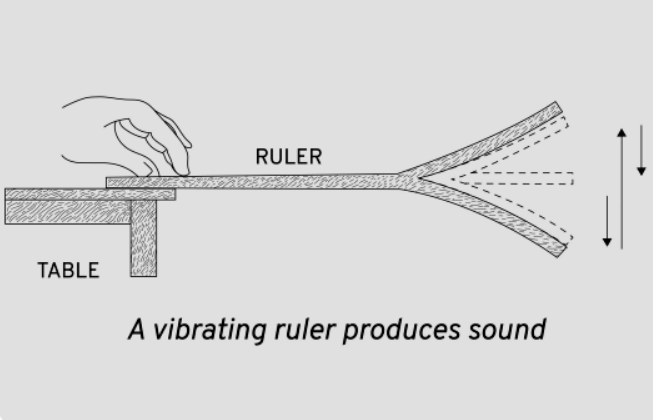
Propagation of Sound
- Medium is anything which is capable of transmitting a sound. A medium can be any solid, liquid or gas. Sound travels from its point of generation to the listener via a medium. When an object vibrates, it enables the medium particles to vibrate. They do not move from the vibrating object to the ear; instead, one particle comes in contact with the object and gets displaced from its equilibrium position. A force is exerted on the adjacent particle, which results in the displacement of this particle, which enables the first particle to come back to its initial position. This process is repeated until the sound reaches our ears.
- A disturbance that moves through any medium when its particles cause the neighbouring particles into motion is called a wave. In turn, they develop similar motions in other particles. The medium particles do not travel forward by themselves; instead, the disturbance makes them move forward. This is the mechanism of propagation of sound in a medium; thus, the sound can be visualised as a wave. Sound waves are mechanical waves that enable the motion of particles in the medium. The most common medium by which sound travels is the air.
- When a vibrating body moves forward, it creates a region of high pressure called compression (C). The air begins to move away from the vibrating object. When this vibrating object moves back, it creates a region of low pressure called rarefaction(R). Thus, air comprises a series of compressions and rarefactions due to the rapid movement of objects backwards and forward. Thus, sound waves are propagated through the medium.
Pressure = number of particles in the medium/volume.
More density produces more pressure and vice versa.
So, sound propagation can be seen as the propagation of variations in density or variations in pressure in the medium.
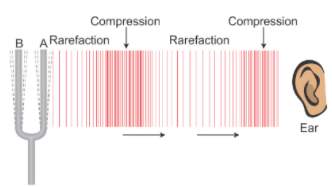
Medium of Sound waves
- Air, water, and Steel are the material media needed by sound to travel and propagate. Sound is unable to travel through a vacuum. Let us understand this through this experiment.
- An electric bell and a glass ( airtight ) were taken. The electric bell was hung inside this airtight bell jar, which was further connected to a vacuum pump. When the switch was pressed on the sound of the bell was heard. When the air in the jar started pumping out, the sound became lower even though the same current was passing through the bell. Gradually, when little air was left inside the bell jar, a very weak sound was heard.
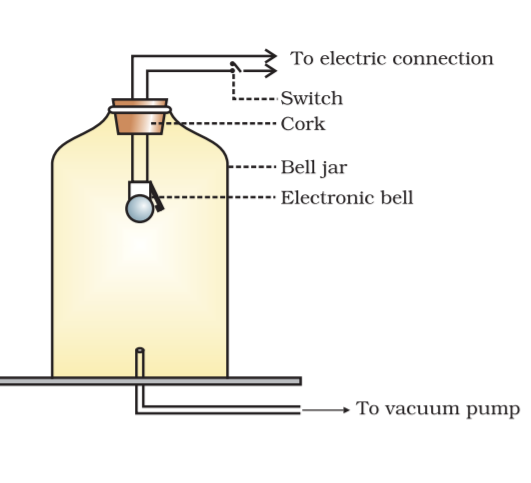
-
Sound waves are longitudinal:
Compressions (C) are the regions where the coils become closer, while rarefactions(R) are the regions where the coils become further apart.
Sound travels in a series of compressions and rarefactions in a medium. Sound waves are longitudinal waves where the individual particles of the medium travel in a direction parallel to the direction of propagation of the disturbance. These particles are immovable and cannot travel from one place to another. They oscillate backwards and forward about their resting position. This is the property of longitudinal waves, and hence, sound waves are regarded as longitudinal waves.

Characteristics of a sound wave:
- A sound wave is demonstrated by its frequency, amplitude and speed.
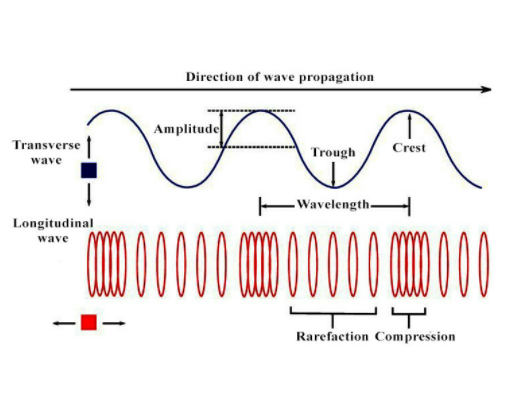
- The graphical representation of a sound wave shows how density and pressure change whenever the sound wave travels through a medium. The density and pressure at a given time change with distance above and below the average value of density and pressure. These figures show the variations in density and pressure when a sound wave travels in the medium.
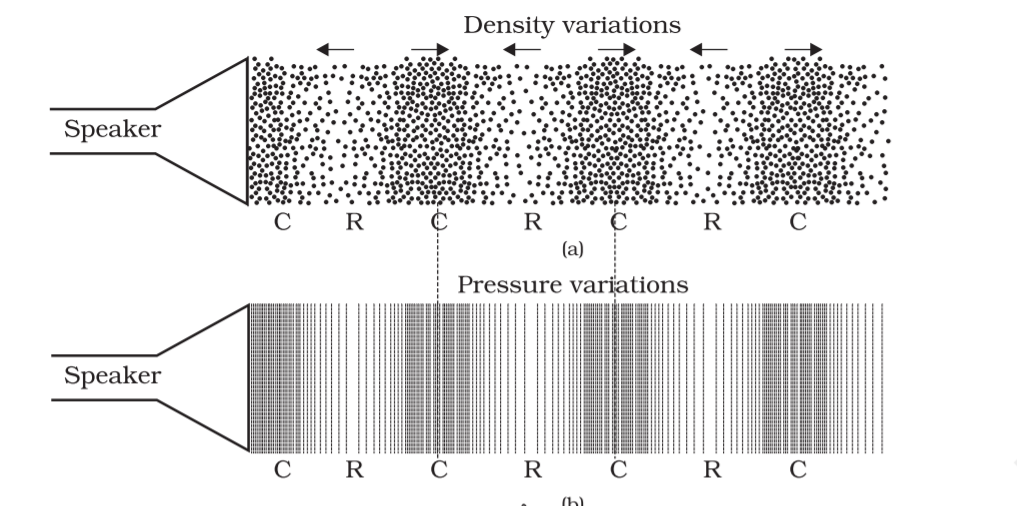
- The region of compressions contains the particles present together, which is represented by the upper portion of the curve. Peak is known as the region of maximum compression. The density and the pressure are always high in the regions of compression. The areas of lower pressure where the particles are seen spreading are shown by a valley known as rarefaction, which is situated in the lower portion of the curve. The crest is the peak of the graph, while the valley of the graph is called the trough of a wave.
-
Wavelength: It means the distance between two consecutive compressions (C) or two consecutive rarefactions (R). The symbol for wavelength is λ. The SI unit of wavelength is the meter(m).
- Frequency: is the number of times a body vibrates.
- The maximum value of density to its minimum value and then again to its maximum value form one oscillation. The number of oscillations per unit time is the frequency of the sound wave. It is also the number of compressions or rarefactions that cross per unit time. The symbol for frequency is while the SI unit of frequency is hertz(Hz).
- Time period: It is the time occupied by two compressions or rarefactions, one after the other, to cross a specific point.
't' is the time taken for one complete oscillation in the density of the medium. T is the symbol of the time period, and its SI unit is second (s).
- Relation between frequency and time period:
T= 1/f
Terms related to sound waves:
- Pitch: It is the interpretation of the frequency of an emitted sound.
When the vibration of the source is faster, the frequency and therefore the pitch become higher. High pitch represents more compressions and rarefactions passing a fixed point per unit time.
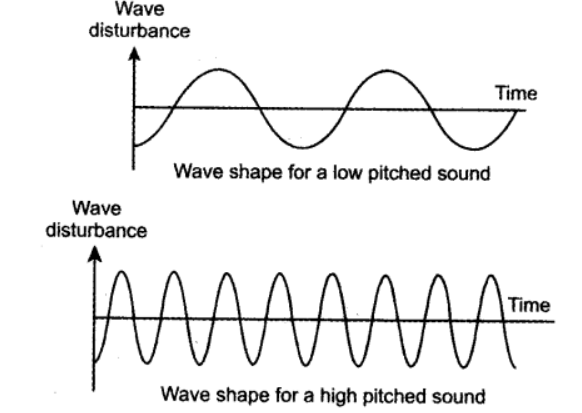
- Amplitude( A): The magnitude of the maximum displacement is called amplitude. The unit of amplitude is the same as the unit of density or pressure. The amplitude determines the loudness or softness of a sound and depends upon the force with which an object is vibrated. When a sound wave moves away from its source, its amplitude and loudness decrease.
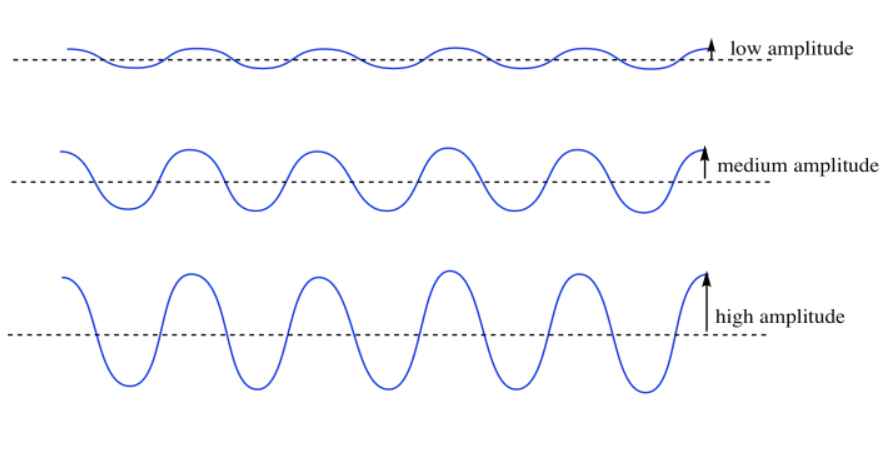
- Quality or Timber: It helps us to differentiate one sound from another sound of the same pitch and loudness. A pleasing sound is said to be of rich quality, while an unpleasant sound is regarded as noise. Music is soothing to our ears and is of rich quality. A sound of a single frequency is known as a tone, while a sound that is developed because of a mixture of many frequencies is called a note.
- Speed (S)= Distance/Time = d/T, SI Unit: meter/second (m/s)
- Wavelength (λ ) of the sound wave is the distance moved by the sound wave in one time period (T) of the wave.
S= λν
speed = wavelength × frequency
- Intensity of sound: It is the amount of sound energy travelling each second through a unit area.
- Loudness: It is defined as a measure of the response of the ear to the sound.
Speed of sound in different media:
- The speed of the sound is dependent on the characteristics of the medium through which it propagates/travels.
- The speed of sound is dependent on the temperature of the medium. For example, the speed of sound reduces when an object is changed from a solid to a gaseous state.
- A table is given which represents the speed of sound in various media.
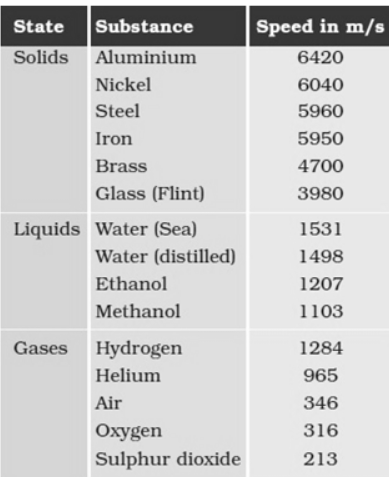
Reflection of Sound
- The reflection of sound occurs at the surface of a solid or liquid. Sound also follows the laws of reflection.
- Laws of reflection:
1. The incident ray, the reflected ray and the normal lie in the same plane, that is, the reflecting surface
2. The angle of incidence is always equal to the angle of reflection.

Echo:
- When our sound reaches a suitable reflecting object, such as a mountain, an echo is heard. It remains for only 0.1 seconds.
- Conditions for hearing echo:
1. The time difference(interval) between the original sound and the reflected sound must be at least 0.1 seconds.
2. The minimum distance of the reflecting surface from the source of sound must be 17.2 m.
- Due to successive or multiple reflections, echoes are heard again and again. Example- rolling of thunder.
Reverberation:
- The sound caused by repeated reflections from a reflecting object is called reverberation.
- The roof and walls of a big hall are generally covered by sound-absorbent materials like compressed fiberboard.
- Uses of multiple reflections of Sound:
-
Musical instruments like a megaphone and a horn are made up of a tube, which is followed by a conical opening.

-
It is used in a stethoscope, which is used for hearing sounds developed within the body. The sound of the patient’s heartbeat is heard by the doctor’s ears through multiple reflections of sound.
-
Ceilings of auditoriums are made curved aiming that sound after reflection reaches all corners of the hall.
Range of Hearing:
- Audible range of hearing of sound for humans varies from about 20 Hz to 20000 Hz.
- Those sounds whose frequencies are below 20 Hz are known as infrasonic sounds.
- The communication of the rhinoceros is done at 5 Hz. Whales and elephants also communicate through infrasonic sounds.
- The frequencies which are higher than 20 kHz are known as ultrasonic sounds or ultrasounds.
- Dolphins and bags produce ultrasounds.
- Children who are under the age of 5 and some animals, like dogs, have the capacity to hear up to 25 kHz
Ultrasound
- Ultrasounds have frequencies which are capable of travelling through every part, even in the presence of obstacles. They are mainly used in industries and in the medical sector.
1. These high frequencies clean spiral tubes, electronic components and several other places which are hard to reach. The objects that need to be cleaned are put in a cleaning solution, and the ultrasonic waves are passed through the solution. Because of the high frequency of these particles, the dust particles and the dirt get removed, and the object becomes clean
2. Ultrasonic vibrations are used to find cracks and flaws in metal blocks. These metal blocks are used for the construction of buildings and scientific equipment. The floors or the cracks inside these are invisible from the outside. It reduces the strength of the buildings and machines. Ultraviolet waves are passed through these metal blocks to cure this, and the detectors function to detect the propagated waves. When any small defect is encountered, these ultrasound reflects back, which indicates the presence of any crack.

3. Ultrasonic waves are used in the technique of echocardiography. This technique makes the ultrasonic waves reflect from various parts of the heart and develop its image.
4. Ultrasonic waves are also used in ultrasound scanners to produce images of internal organs of the human body. It is used to detect any fault in the liver, gallbladder, uterus, etc. The technique by which the images are displayed on a monitor is called ultrasonography.
5. The ultrasonic waves are also used to break small stones formed in the kidneys or liver, which are removed with the urine of the individual.
Sonar
- The expanded form of Sonar is Sound navigation and ranging.
- It is an instrument which uses ultrasonic waves to measure the distance, direction and speed of objects inside water.
Working:
Sonar constitutes a transmitter and a detector, which are installed in a boat or a ship. Ultrasonic waves are produced and transmitted by the transmitter, which travel through water and strike the object on the seabed. The waves are reflected back and are sensed by the detector. The detector converts the waves into electrical signals for interpretation. The object's distance, which reflects the sound wave, can be measured by determining the speed of sound in water and the time period between transmission and reception of the ultrasound.
If the time interval is t, and the speed of sound is S, the total distance, 2d, travelled by the ultrasound becomes,
2d= S×t
This technique is known as echo ranging.
The Sonar technique is also used in various other determinations to calculate the depths of the sea and to detect the location of underwater hills, submarines, sunken ships, etc.

NCERT Class 9 Science Chapter 11 Sound: Previous Year Question and Answer
NCERT Class 9 Science Chapter 11 sound previous year questions and answers offer a pre-focused and test-oriented information to enable the students to know the kind of questions that are typically set in the exams at school. These PYQs bring out the key ideas, formulas and uses that commonly occur in tests, which enables students to study in a more strategic way. Having properly organised responses according to the new CBSE guidelines, they can be used to enhance conceptual clarity and maximise the scoring potential. These questions will help enhance confidence and provide adequate revision of the chapter.
Q1: A person is listening to a tone of 500 Hz sitting at a distance of 450 m from the source of the sound. What is the time interval between successive compressions from the source?
Answer:
The time interval between successive compressions from the source is equal to the time period, and the time period is the reciprocal of the frequency. Therefore, it can be calculated as follows:
T= 1/F
T= 1/500
T = 0.002 s.
Q2: A stone is dropped from the top of a tower 500 m high into a pond of water at the base of the tower. When is the splash heard at the top? Given g = 10 m s−2 and speed of sound = 340 ms−1.
Answer:
Height (s) of tower = 500 m
Velocity (v) of sound = 340 m s−1
Acceleration (g) due to gravity = 10 m s−1
Initial velocity (u) of the stone = 0
Time (t1) taken by the stone to fall to the tower base
As per the second equation of motion:
s= ut1 + (½) g (t1)2
500 = 0 x t1 + (½) 10 (t1)2
(t1)2 = 100
t1 = 10 s
Time (t2) taken by sound to reach the top from the tower base = 500/340 = 1.47 s.
t = t1 + t2
t = 10 + 1.47
t = 11.47 s.
Q3: A sonar device on a submarine sends out a signal and receives an echo 10 seconds later. Then what is the speed of sound in water if the distance of the object from the submarine is 7200 m?
Answer:
Time (t) taken to hear the echo = 10 s
Distance (d) of an object from submarine = 7200 m
Total distance travelled by SONAR during reception and transmission in water = 2d
Velocity (v) of sound in water = 2d/t = (2 × 7200) / 10 = 1440 ms-1
How to Master Class 9 Science Chapter 11 Sound?
Learning Class 9 Science Chapter 11 is a lot easier when you have a very clear picture of how to make sound waves, how the sound waves travel in different media and how their characteristics influence what we hear. This chapter is very scoring and concept-based, and, therefore, a combination of visualisation, practice, and real-life examples assists in the development of strong clarity. Having a good studying plan, it is very easy to understand the concepts of waves and excel in exams.
- Begin by reading the chapter in the NCERT through which you can learn the mechanism of the production of sound and its travel as a longitudinal wave.
- Understand the definitions of terminologies such as frequency, amplitude, wavelength, echo, reverberation, and ultrasound with real-life examples.
- Learn the important formulas, including v = fλ, and practice them every day by means of numerical questions.
- Observe diagrams of waveforms, compressions, rarefactions, and the human ear structure to strengthen visual understanding.
- Solve all NCERT exercises, examples, and exemplar questions to gain confidence in theory and numericals.
- Make brief notes on formulas, definitions, and other key concepts to revise in a quick way prior to the tests.
- Associate concepts with real-life examples, such as echoes in empty rooms or sound in rail tracks or noise absorption, to enhance the clarity.
- Solve past year questions, sample papers to get to know the patterns of the exams.
- Revise the chapter on a regular basis so as to remember formulae and conceptual details.
NCERT Notes Class 9 Science Chapter-Wise
The NCERT Notes on Class 9 Science Chapter-Wise give a comprehensive and properly organised set of study resources on all the chapters in the syllabus. These notes are structured by experts in subjects to make the concepts simple and explain them with clear explanations, diagrams, formulas, and key points. They assist students to revise in a short time, brush up on basics and do well in examinations. Chapter-by-chapter links provide students with the opportunity to access every topic and study in a structured and efficient way.
NCERT Solutions Of Class 9 Subject-Wise
NCERT Class 9 Exemplar Solutions for Other Subjects:
Frequently Asked Questions (FAQs)
Applications include medical ultrasound, sonar in submarines, musical instruments, hearing aids, and soundproofing systems.
Yes, basic concepts from this chapter are foundational for understanding physics in higher classes and are useful in Olympiads, NTSE, and NEET foundation.
Ultrasound refers to sound waves with frequencies above 20,000 Hz. It is used in medical imaging (like sonography), cleaning delicate equipment, and detecting flaws in metals.
Yes, exposure to very loud sounds can damage hearing. Continuous exposure to noise above 85 dB can be harmful to the ears.
Studying sound helps students understand how we hear, how vibrations produce sound, and how sound is used in technology, medicine, and everyday life.
Courses After 12th
Applications for Admissions are open.
As per latest syllabus. Physics formulas, equations, & laws of class 11 & 12th chapters
JEE Main Important Chemistry formulas
Get nowAs per latest syllabus. Chemistry formulas, equations, & laws of class 11 & 12th chapters
JEE Main high scoring chapters and topics
Get nowAs per latest 2024 syllabus. Study 40% syllabus and score upto 100% marks in JEE
JEE Main Important Mathematics Formulas
Get nowAs per latest syllabus. Maths formulas, equations, & theorems of class 11 & 12th chapters
